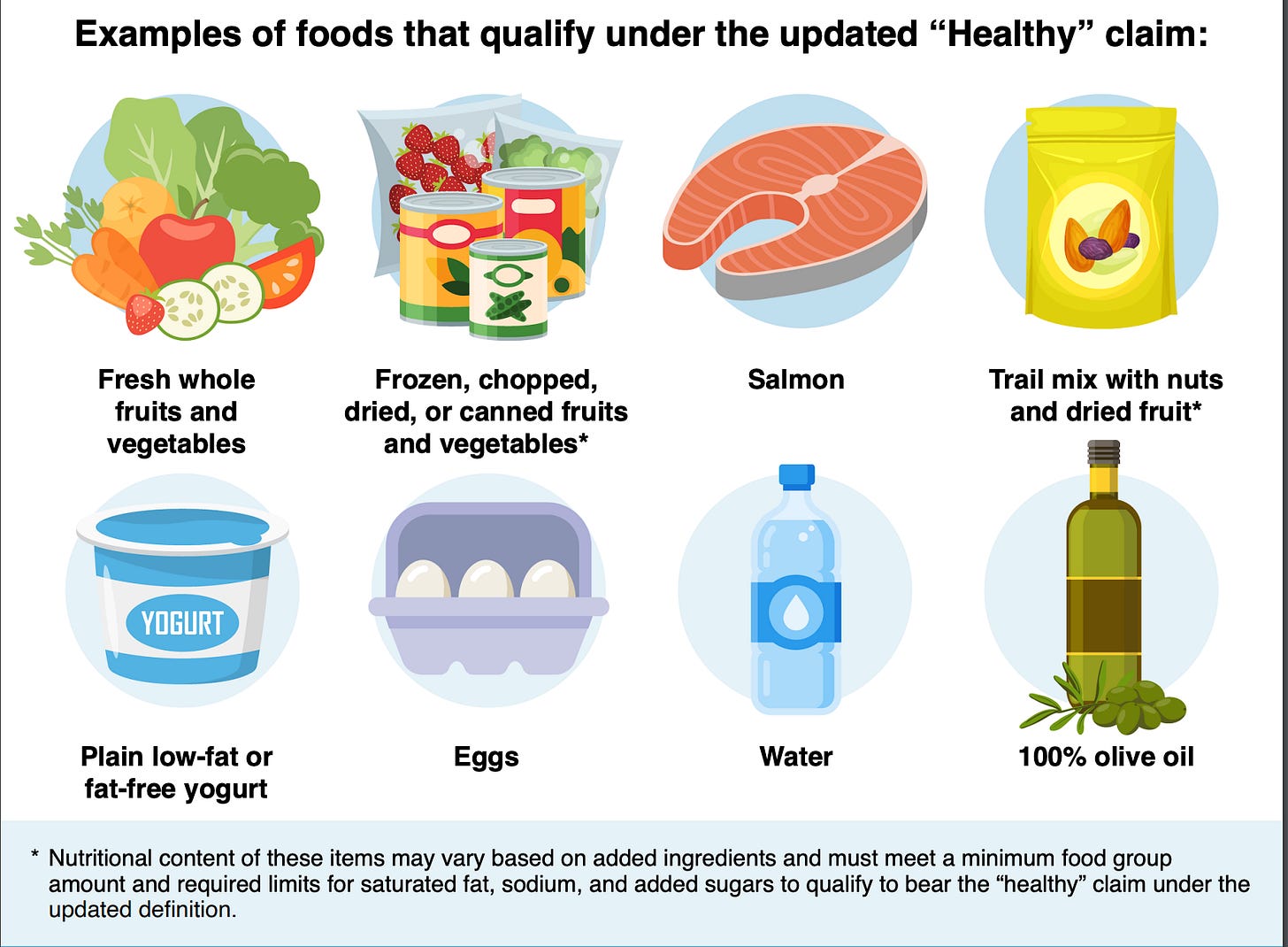Secret's Out, This is What's Healthy
The newsletter that's pretty much the nirvana of healthful tastiness! [This statement has not evaluated by the FDA]
Most of the time when I mention to someone that I studied nutrition and write about food systems, they follow up by asking if [insert fad diet, product, trend, nutrient] is healthy. My response is always, “What does ‘healthy’ mean to you?” That usually cuts that conversation pretty short. I know they’re looking for a yes or no confirmation that [fad diet, product, trend, nutrient] is “good” or “bad”. But the answer to, “what is healthy” is different for everyone and, on top of that, we all have our own ideas of what healthy even means.
However, there is one instance where I can tell you exactly what “healthy” means, and that’s on FDA-regulated foods. On December 19th the FDA announced a new final rule that updates what “healthy” means for food labeling. This rule was officially published on December 27th, though it doesn’t go into effect until February 25, 2025, and the compliance date isn’t until February 25, 2028. Oooooh exciting!
If people were interested in having a full conversation about “what is healthy” rather than a 1-2 sentence answer that feeds their confirmation bias, I—unsurprisingly—would have a lot to say. I would start with a fun little history lesson—please let me stay delulu thinking that everyone is as fascinated by the nitty gritty of US food regulation as I am—to bring them up to speed on the past 3 decades of relevant FDA lore. This regulatory context is necessary to fully appreciate my not-so-hot take on “what is healthy” and, more importantly, what I think our fascination with that concept says about our world.
“Healthy” Labeling Lore
The term “healthy”—and related terms like “healthful,” “healthfully,” “healthfulness,” “healthier,” and “healthiest”—became FDA-regulated in 1994. These terms fall into the category of an implied Nutrient Content Claim (NCC), which describes either a certain nutrient level that is present or not present in a food or suggests that the food would be helpful to maintain healthy dietary practices. This means that if a company wanted to stick “healthy” on its packaging, it would have to meet all of the requirements for an implied NCC or face the wrath of a stern warning letter from the FDA.
This 90’s version of “healthy” that stuck around until this month put limits on saturated fat, sodium, total fat, and dietary cholesterol and required minimum amounts “of beneficial individual nutrients (defined as vitamin A, vitamin C, calcium, iron, protein or fiber)”. It did not set a requirement or limit for calories or sugars. So foods that qualified for this version of the claim included things that were high in added sugars, like yogurts, cereals, and fruit snacks. As anyone alive in the 90s knows, this was on par for the time because fat content was of much greater concern at the time than sugar.
Fast forward to 2015, when this “healthy” rule turned 21. The FDA started drama by sending a warning letter (the agency’s primary enforcement action) to KIND LLC, the company that makes those snack bars that somehow always leave your hands sticky. The letter stated that at least four of KIND's products did not meet the nutrient claims listed on their labels, which violated the Federal Food, Drug, and Cosmetic Act, specifically 21 CFR 101.65(d)(2).
The FDA took issue with several product claims. For example, the bars labeled as “healthy” and “high fiber” weren’t technically low in saturated fat, which violated the NCC requirements. Additionally, the bars that advertised “antioxidant-rich dark chocolate” didn’t contain enough vitamin C, vitamin E, or beta-carotene to meet the 20%+ Reference Daily Intake (RDI) requirement for this claim. KIND’s website was also called out for statements like, “There’s healthy. There’s tasty. Then there’s healthy and tasty,” and “All of our snacks are pretty much the nirvana of healthful tastiness.”
In response to the letter KIND took “healthy” off packaging but insisted that its use of “healthy” wasn’t intended to be an NCC. Although it heeded the FDA’s warning, KIND didn’t forgive and forget. In December 2015, the company filed a citizen petition requesting that the FDA examine its out-of-touch stance that excluded nutrient-dense foods with “good fats” from being considered “healthy”. KINDs’ call out resonated with many other companies, people, and the media and pushed this conversation about what’s “healthy” into the mainstream. By May 2016, the FDA walked back the warning letter and let KIND return to using “healthy” in its labeling. Then the FDA took the initial steps to update the “healthy” NCC and announced a request for comment—citing concern from a variety of stakeholders, including KIND—that eventually resulted in our 2024 version of “healthy”.
Jump to 2018 and another petition reinvigorated the discussion about what the FDA’s version of “healthy” was overlooking. This time the discussion centered around one food in particular—eggs. This took place during my first year of grad school and I remember that the question, “Are eggs healthy or not?” was everywhere. From my research, it seems we can credit Pete and Gerry’s Organics, an egg producer, for this cultural moment. (Side note since we’re about to enter 2025…the fact that 2018 took place 7 years ago really really hurts my brain.) Pete and Gerry’s was inspired by KIND’s petition and pushed to expand the conversation on healthy fats to include salmon, avocados, and most importantly *drum roll* eggs.
In 2022, the FDA introduced a proposed rule to update the “healthy” NCC so it would be more consistent with current nutrition science and the Dietary Guidelines for Americans. A proposed rule is the progression from an FDA’s request for comment, like the one announced in 2016. This proposed action emphasized nutrient-dense foods and discussed the need for more flexibility in guidelines to keep up with industry innovation. Once a proposed rule is announced the FDA accepts public comments on it and then works to develop it into a final rule. And that was the final rule just published on December 27th.
Included in this new rule are major changes to what “healthy” means in 2024 and beyond. Going forward the “healthy” NCC will place limits on saturated fat, sodium, and added sugars. Foods that want to use this NCC are now required to contain a “minimum amount of recommended food groups and sub-groups (vegetables, fruits, dairy, protein foods, whole grains)”. This is different from the previous requirement for minimum amounts of beneficial individual nutrients. The significance of this change is the shift in the FDA’s focus from individual nutrients to the broader food groups and sub-groups, which is more consistent with current nutrition recommendations.
So What Do I Think?
Personally, the FDA’s definition doesn’t alter what I think is “healthy” and I can’t see it impacting my future food purchases. This is because I don’t make (conscious) choices based on labeling claims or other marketing; however, I am not the average shopper. If we zoom out and consider average people—who don’t live in the bubble of regulation, policy, academia, and science—how does this news impact them? Most people won’t know that “healthy” had a super specific regulatory definition in the first place but this doesn’t mean that seeing “healthy” on a label doesn’t influence them.
Research shows that people engage in heuristic processing—individualized mental shortcuts—when deciding what foods to buy. Making all those choices is overwhelming and heuristic processing is a way for our brain to ease that overwhelm. Buzzwords, like “healthy,” along with other sensory and cognitive clues, all play into this type of decision making. So while the average person isn’t choosing a product with a “healthy” claim because of its new regulatory definition, it is a factor in their heuristic processing and ultimate purchasing decision.
Successful food marketing thrives on our brain’s tendency toward heuristics and pairs well with our cultural landscape, which favors a reductionist approach to food, nutrition, and health. This reductionism leads us to fixate on individual nutrients, food components, or purported benefits, instead of a more holistic picture. While nutritional reductionism can serve a purpose, I think that purpose mainly lives within the aforementioned bubble of research and healthcare settings. Outside of the bubble reductionism has created a culture that thrives on the oversimplification of complex concepts, sexy buzzwords, fear or anxiety, and purported quick fixes that promise that buying this product or trying that diet will finally deliver us to being “healthy.”
It also makes it easy to create fear out of the tiniest element, regardless of whether or not the fear is founded. This ecosystem feeds into our desires for a quick-fix solution and gives us the idea that we can control, or even optimize, every aspect of our health. It’s even more enticing when the idea of control is fed to us as something subversive, a secret to wellness that they don’t want you to know. It’s why dangerous elimination diets, like carnivore or keto, and detox protocols can be so enticing. It’s why the anti-seed oil movement has taken off so quickly and how the narrative that vegetables are toxic, unfortunately not satire, is spreading.
Within this ecosystem, we are never set up to win. We will never reach “healthy” because health is commodified and we have created multibillion-dollar industries that will keep moving the goalposts. There will always be another ingredient we’re convinced we need to fear or a new diet or supplement we must have to optimize our wellbeing. Our obsession—I do not use that word lightly—with individualized wellness has coopted the healthy conversation.
Bringing it All Together
In a way, the FDA's "healthy" label updates are just a small part of a much bigger story about how we approach health in modern society. An approach that favors the quick fix and oversimplifies the complexities of human health. This reductionist mindset encourages us to focus on the minutia, ignoring the broader context in which food choices are made and how they impact us. And it’s not just about the foods we eat, but about the way we think about health itself and how we understand—or don’t understand—that health must look different for each person. Food marketing willfully ignores this nuance and capitalizes on our mental shortcuts, offering us an illusion of control over our well-being, this ecosystem thrives on confusion and fear, rather than providing us with the tools to make truly informed decisions.
And when we step back to consider the larger context it becomes clear that our fixation on individualized health has distracted us from addressing the real issues that impact people's access to food, healthcare, and other structural elements that promote health. The focus on personal responsibility, coupled with ever-shifting understandings of what’s "healthy," prevents us from grappling with the deeper, structural issues that affect the health of entire populations. Until we break free from this cycle of commodifying health and start addressing the root causes of the inequities of our food system, we'll continue to chase an elusive, ever-changing definition of "healthy," while missing the bigger picture of what it truly means to be well.








Really interesting! Thanks as always for your insight; it's really helpful for digesting all this (pun somewhat intended).
I’m in Canada but I know that we’re greatly influenced by US advertising and food so found this really interesting. I always wonder when someone says something is “healthy” what they really mean. I think everyone has their own definition and lots of people are really judgemental about others food choices.